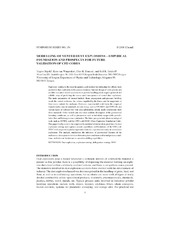Modelling of vented dust explosions – empirical foundation and prospects for future validation of CFD codes
Chapter, Peer reviewed
Published version
Permanent lenke
https://hdl.handle.net/1956/8949Utgivelsesdato
2008Metadata
Vis full innførselSamlinger
Originalversjon
In: Hazards XX: process safety and environmental protection: harnessing knowledge, challenging complacency: 838-850Sammendrag
Explosion venting is the most frequently used method for mitigating the effects from accidental dust explosions in the process industry. Optimal design of vent systems and credible execution of risk assessments in powder handling plants require practical and reliable ways of predicting the course and consequences of vented dust explosions. The main parameters of interest include flame propagation and pressure build-up inside the vented enclosure, the volume engulfed by the flame, and the magnitude of blast waves outside the enclosure. Extensive experimental work forms the empirical foundation for current standards on vent sizing, such as EN 14491 and NFPA 68, and various types of software for vent area calculations simply apply correlations from these standards. Other models aim at a more realistic description of the geometrical boundary conditions, as well as phenomena such as turbulent compressible particleladen flow and heterogeneous combustion. The latter group include phenomenological tools such as EFFEX, and the CFD code DESC (Dust Explosion Simulation Code). This paper briefly reviews the empirical foundation behind modern guidelines for dust explosion venting, and explores current capabilities and limitations of the CFD code DESC with respect to reproducing results from one experimental study on vented dust explosions. The analysis emphasizes the influence of geometrical features of the enclosures, discrepancies between laboratory test conditions and actual process conditions, and inherent limitations in current modelling capabilities.
Beskrivelse
Presented at: HAZARDS XX, Manchester, 23–25 November 2008
